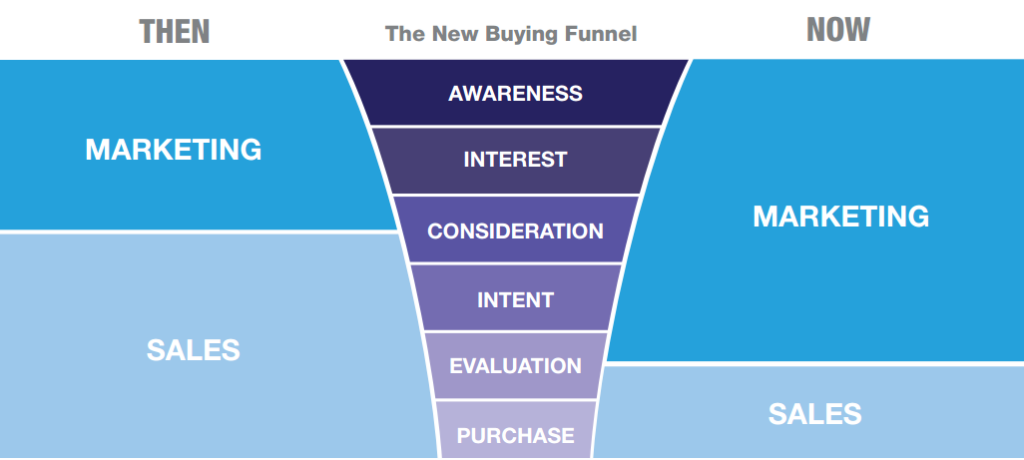
The Essential Guide to Sales and Marketing Alignment
If your organization is like most, sales and marketing are likely entirely separate teams, with different goals, different tactics, and different definitions of success.
At worst, these teams may find themselves embroiled in an adversarial relationship, with lots of friction when they are forced to work together.
That’s a real shame, because the fact is, sales and marketing go together like peanut butter and jelly. In some organizations, they’re even combined into one integrated approach — known as “smarketing”.
While you don’t have to go quite as far as completely merging your sales and marketing teams, there are some compelling reasons to get them aligned.
Why is sales and marketing alignment important?
When sales and marketing aren’t aligned, the result is often frustration on both sides and a massive waste of resources.
Sales is annoyed because marketing sends them poor quality leads that don’t convert. One study found nearly 75% of marketing leads don’t convert into a sale, often because these leads simply aren’t well-qualified.

Via Hubspot
Meanwhile, marketing feels like sales is dropping the ball, by not converting the leads they send, and not using the content they create. According to one study, as much as 80% of the content that marketing generates for sales is never used!
The root problem is a lack of alignment on the goals and strategy that will drive results for both teams and the organization as a whole.
Related: Guide to New Outbound Sales Strategies
Better together: Compelling sales and marketing alignment statistics
On the other hand, when sales and marketing are able to collaborate effectively, they can drive some impressive results. Just look at these sales and marketing alignment statistics:
- Organizations with tightly-aligned sales and marketing had 36% higher customer retention rates and 38% higher sales win rates. (MarketingProfs)
- Aligned organizations saw an average of 32% annual revenue growth.
- Less aligned companies reported an average 7% decline in revenue. (Forrester Research)
- When sales and marketing were aligned, businesses had a 67% higher chance of closing marketing-generated leads. (Marketo)
- Businesses with aligned sales and marketing departments generated 209% more revenue from marketing. (Marketo)
Impressive, right? But maybe you’re wondering what sales-marketing alignment actually looks like in practice. Let’s take a look.
How to achieve sales-marketing alignment
We’ve seen that sales and marketing can both be more productive and generate more revenue when they collaborate. Here’s how to actually make it happen.
1. Get aligned around the same goal
While marketing teams may have longer-term goals like building a strong brand, growing awareness, and generating leads, sales tends to have shorter-term monthly or quarterly quotas they’re striving to meet.
Aligning around one goal, for example, number of leads or a revenue goal, ensures everyone is on the same page.
2. Define roles and responsibilities
It’s not uncommon for the sales and marketing team’s efforts and responsibilities to overlap. This is to be expected in an aligned team — however, it’s still important to make sure the team has a clear understanding of expectations, roles, and responsibilities.
3. Outline a Service-Level Agreement (SLA)
When used internally, an SLA is an agreement between the sales and marketing teams that outlines how each team will support their shared goals. It will outline the goals and metrics for each team, the deliverables each is responsible for, and the consequence if a goal is not met.
It should also outline what constitutes a lead, and a qualified lead, and what processes each team will follow throughout the process.
4. Meet regularly
Communication is key! Marketing and sales teams should meet regularly to keep each other in the loop on their goals, activities and key metrics.
The managers of each team should also be meeting regularly to look at metrics like lead generation and conversion rate, MQLs (marketing qualified leads) and other results.
The teams should also be spending quality time together outside of the office — happy hours and off-site activities help to build connection and personal relationships between the two teams.
5. Collaborate on content
Sales talks to customers every day — they know first-hand what questions they have and what problems they’re looking to solve. Sales and marketing should brainstorm content together and collaborate on content and campaigns that will support sales and provide value to customers.
6. Deploy the right tools
Aligned sales and marketing teams should be using the right tools. These include:
Customer Relationship Management (CRM)
A CRM (Customer Relationship Management system) is an absolute must for an aligned, effective sales and marketing team. A shared CRM like Salesforce or Zoho lets the entire team track prospects and customers throughout the life-cycle.
Project management
A shared project management tool like Trello or Asana will help keep aligned teams on the same page. Break down campaigns into projects, track deadlines and deliverables and assign tasks to key stakeholders.
Marketing automation
A marketing automation tool like HubSpot or Salesforce’s Pardot is essential for warming up prospects through targeted email and social media campaigns. It’s also a valuable tool for lead scoring While it may be mostly owned by marketing, given email’s importance in driving leads, sales teams should also be involved in helping to create messaging for nurture campaigns and behavior-triggered emails.
Related: How to Use Marketing Automation to Warm Up Prospects
Sales intelligence
A sales intelligence tool like Winmo helps sales teams discover new sales opportunities and stay up to date on the latest technology, trends, and organizational shifts.
While sales might mostly own the tool, marketing can benefit from greater insight and data on customers, HubSpot and Salesforce integrations, as well as features like uploading a list where marketers can easily upload a targeted account list and append relevant contact details.
Related: 2019 Guide to Brilliant Data-Driven Marketing
Final thoughts
The ways that sales and marketing teams work together is changing. The hand-off from marketing to sales now happens much later in the customer journey. Customers today do more research online before ever contacting a vendor, with marketing playing an important role throughout more of the buying process.
Sales meanwhile, tends to come in later, taking over when the lead is well-qualified and much closer to making a purchase decision.

Via Marketo
When marketing and sales are well-aligned, they can become a finely oiled, revenue-generating machine. But when they’re not? The lost sales productivity and wasted marketing budget can end up costing companies an incredible $1 trillion each year (yes, that’s trillion with a T!)
In order to align your sales and marketing teams, it’s crucial to establish shared goals, get everyone on the same page with an SLA, facilitate collaboration and communication, and build the tool stack that will help the team reach its goals.
Get started with a sales intelligence platform that will give your sales and marketing team a competitive edge, with more sales opportunities and better-qualified leads. Request your Winmo demo today!




